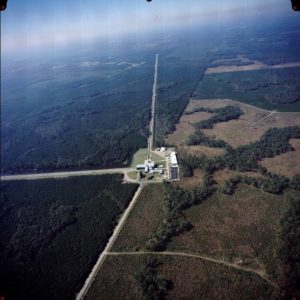A long time ago, in a galaxy that was, yes, far, far away, two massive black holes drew close together. The two stellar ghosts whirled around each other at half the speed of light and collided, sending a shudder through the universe in the form of gravitational waves. Six months ago, those waves rippled past earth. Physicists announced the detection of waves in February, ending a quest that has lasted decades and opening a new door of discovery to the heavens.
For TCU physics instructor Doug Ingram, the discovery could run the range from being a trivial footnote in history or having profound consequences. Either way, it’s something to appreciate.
“Maybe it will be nothing,” Ingram said. “Maybe it’ll just be a historical curiosity, ‘oh, Einstein was right again.’ You never know which one of these fundamental discoveries will revolutionize our lives. You can’t predict that.”
Einstein was right
If nothing else, the discovery reinforces the genius of Einstein, Ingram said.
The detection of gravitational waves, the result of two black holes colliding, proved a part of Einstein’s 100-year-old theory of relativity.
“Einstein is pretty much batting 1.000,” Ingram said. “Everything he predicted about space, about time, and about relativity is correct right down to the last significant digit. It’s incredible that he was able to think up all of this without any experimental verification.”
Senior physics major Thomas Paz said the discovery proved Einstein’s true genius.
“It’s pretty amazing,” Paz said. “I couldn’t even imagine having the capacity to think up so many predictions about time and space – a concept still very elusive back then.”
Without advanced technology, no one could confirm Einstein’s theories back then, but he thought, “this must be true,” Ingram said.“It’s a great example of how science ought to work.”
And even if it was a long time in coming, the proof of Einstein’s theory sets the classic example for young scientists, says Paz.
“In science you’re supposed to start with a hypothesis and then test it,” Paz said. “Many times in science people work backwards instead of starting with a thought or prediction.”
To put it simply, everything has gravity and gravity is everywhere. Gravity is what keeps Earth tethered to the Sun. If some magical force made the sun completely vanish, Ingram said, the earth would still orbit where the sun used to be for about eight minutes and then “whoosh” we’d take off into outer space because it takes that long for the gravitational influence to get here.

Einstein predicted gravitational waves in his general theory of relativity in 1915 which suggested space-time as a concept and waves would be a distortion of space-time.
“Einstein had discovered that there was something a little bit wrong with our theory about gravity,” Ingram said. “He thought gravity must move at the speed of light and maybe it’s carried by waves.”
However, detecting the waves would require a mammoth event, technological prowess, and a long history of hunting.
“The problem is, gravity is such a weak force that the waves are almost impossible to detect, so we could only detect it if it was some really massive event and we had some really sensitive detectors,” Ingram said. “It was only in the last few years that we were able to build a sensitive enough detector to be able to look and see if Einstein’s predictions were right.”
To detect this cataclysmic event, scientists used an instrument so sensitive it could detect a change in the distance between the solar system and a star four light-years away to the thickness of a human hair, Ingram said.
“We’re excited because we recognize that this could be the first step into a brand new way of observing the universe with gravitational waves instead of light waves, but at the same time, it’s hard to convey why we’re excited because it may not lead to anything,” Ingram said. “We’re excited anytime we discover anything new because we don’t know where it’s going to go. You can’t lie and say, ‘this is going to change everybody’s life.’ It might not.”
The chirp heard ‘round the world
It took only one-fifth of a second to hear the “chirp” of the two black holes colliding, but it took months of meticulous checking to make sure the evidence matched Einstein’s theory.
“They actually take great pains to run the gravitational wave detector so they can’t be fooled by false alarms,” Ingram said.
Ingram said that the physicists working on the project randomly inject false signals to run at different intervals to make sure the computer handles them the right way.
“They recognize it’s such a sensitive measurement that they could be easily fooled, so they’re constantly trying to fool themselves,” Ingram said. “They’re their own biggest skeptics.”
Ingram said that if that black hole collision was a big enough event to set off our gravitational wave detectors then there should be a few of those per year that scientists should be able to detect.
“There will be probably a few of those every decade,” Ingram said. “They actually saw multiple smaller incidents, but they only published the one they were really confident about.”
It’s hard to predict what it means

Black holes are the holy grail of the gravitational wave concept. Until now scientists have only been able to see the aftereffects of collisions and black holes were an enigma themselves.
Ingram said this discovery could open the door to a whole new way to observe the universe.
If gravity acts like waves, Ingram said, scientists could build more sensitive detectors and observe more things than they could before.
“There are things in the universe that we can’t see,” Ingram said. “Gravitational waves will allow us to see into some places we could never see before.”
Ingram said that it starts with building more sophisticated detectors and developing theories to experiment, but the possibilities are numerous.
“There’s no telling,” Ingram said. “That’s science. You’re just kind of groping around in the dark hoping you stumble on something major.”












